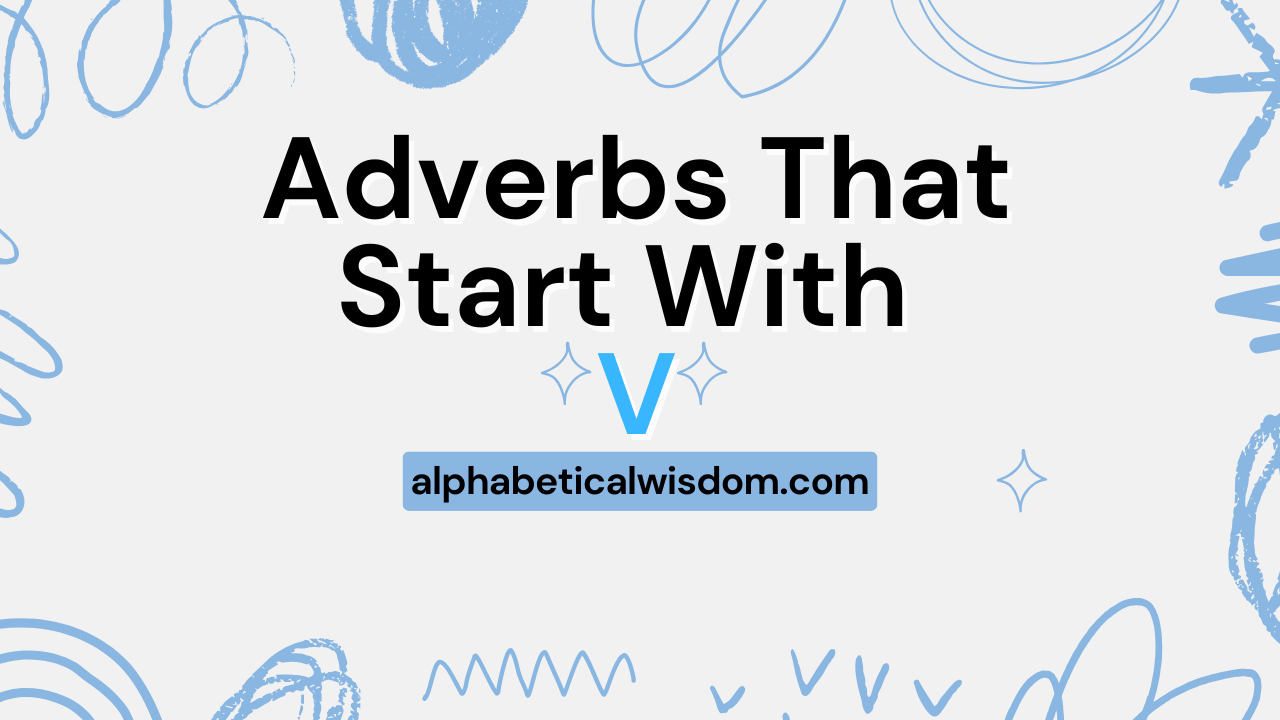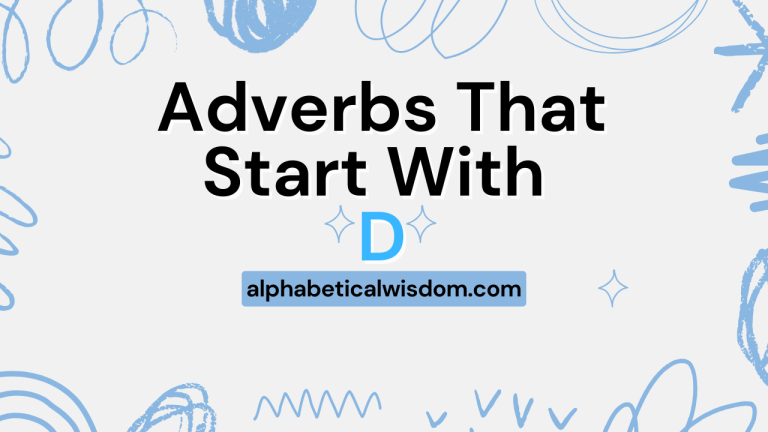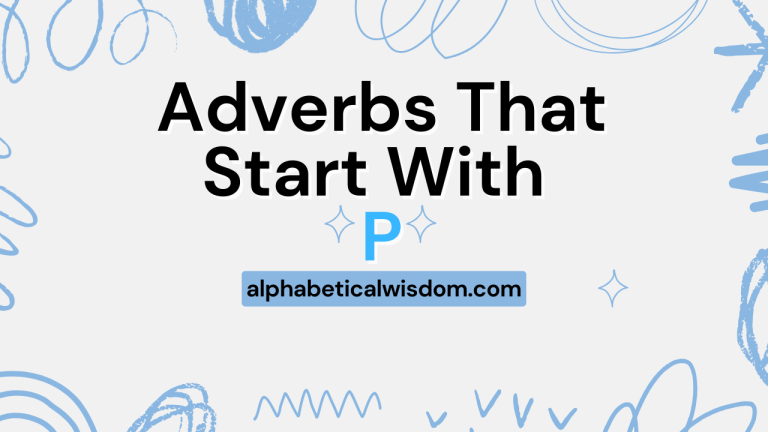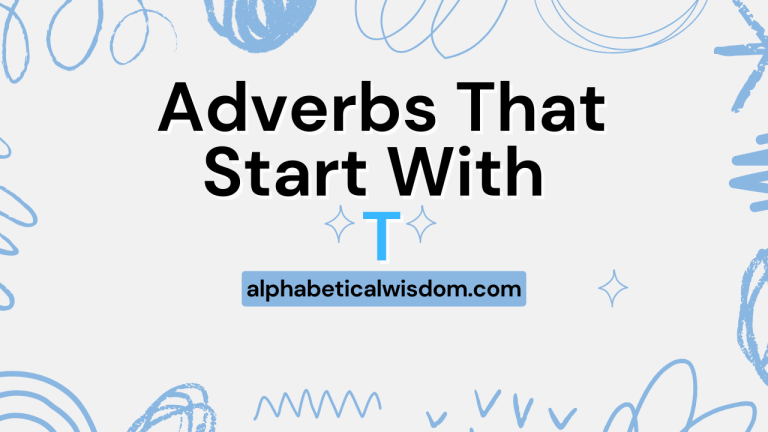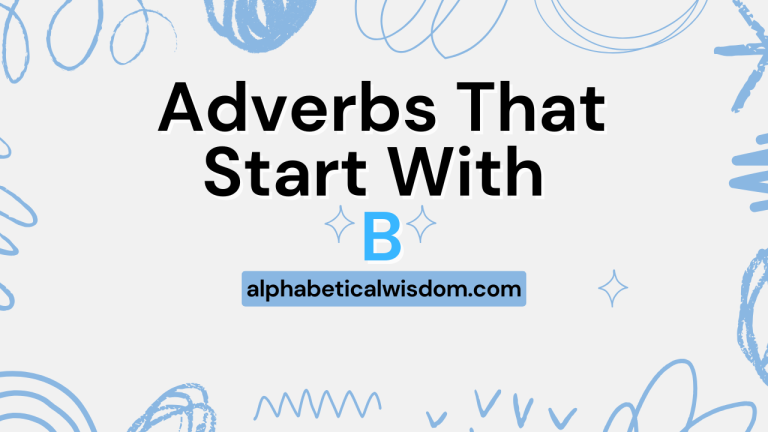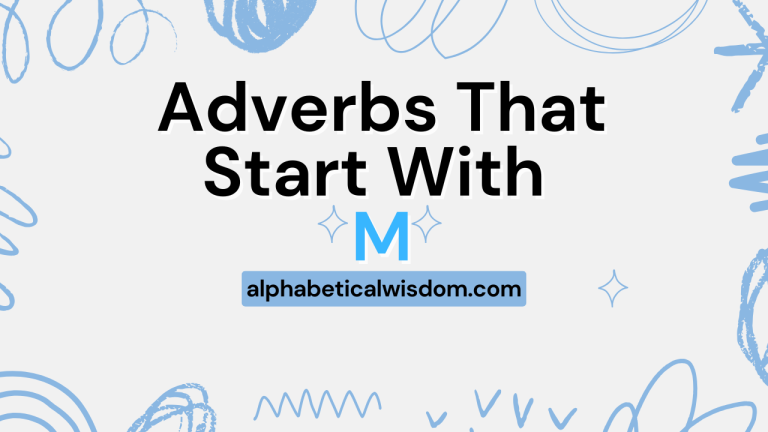Adverbs That Start With V: A Comprehensive Grammar Guide
Understanding adverbs is crucial for mastering English grammar and enhancing your writing and speaking skills. Adverbs modify verbs, adjectives, or other adverbs, adding detail and nuance to sentences.
This article focuses specifically on adverbs that begin with the letter “V,” exploring their meanings, usage, and providing numerous examples to improve your understanding and application of these words. This guide is designed for English language learners of all levels, from beginners to advanced speakers, and anyone looking to refine their grasp of English grammar.
Table of Contents
- Introduction
- Definition of Adverbs
- Structural Breakdown
- Types of Adverbs That Start With V
- Examples of Adverbs That Start With V
- Usage Rules
- Common Mistakes
- Practice Exercises
- Advanced Topics
- FAQ
- Conclusion
Definition of Adverbs
What is an Adverb?
An adverb is a word that modifies a verb, an adjective, or another adverb. It provides additional information about how, when, where, to what extent, or under what condition something happens.
Adverbs are essential for adding detail, precision, and color to your writing and speech, making your communication more effective and engaging. They enhance the descriptive power of sentences, providing crucial context and nuance.
Function of Adverbs
The primary function of an adverb is to modify other words in a sentence. When modifying a verb, an adverb describes the action being performed (e.g., He ran quickly). When modifying an adjective, it intensifies or qualifies the adjective (e.g., She is very beautiful). When modifying another adverb, it adds further detail to the first adverb (e.g., He spoke incredibly softly). Adverbs contribute significantly to the meaning and clarity of sentences.
Context of Adverbs
The meaning and function of an adverb can change depending on the context in which it is used. Some adverbs can have multiple meanings, and their specific role in a sentence is determined by the surrounding words and the overall meaning of the text. Understanding the context is crucial for interpreting adverbs correctly and using them effectively. Consider the sentence, “They arrived virtually on time.” Here, “virtually” means “almost” and provides a specific nuance to the timing of their arrival.
Structural Breakdown
Adverbs can be single words or phrases. Single-word adverbs are often formed by adding “-ly” to an adjective (e.g., quick -> quickly).
However, many adverbs do not follow this pattern (e.g., very, well, quite). Adverbial phrases consist of multiple words that function together as an adverb (e.g., in a hurry, with great care).
Understanding the structure of adverbs helps in identifying and using them correctly in sentences. Recognizing these structures also aids in sentence construction and analysis.
Types of Adverbs That Start With V
While the number of adverbs starting with “V” is relatively small compared to other letters, they still serve diverse functions. Here’s a breakdown of the main types:
Adverbs of Manner
Adverbs of manner describe *how* an action is performed. They provide information about the way something is done.
Common adverbs of manner starting with “V” include “vaguely,” “valiantly,” and “vivaciously.” These adverbs add detail and color to descriptions of actions, making them more vivid and engaging.
Adverbs of Degree
Adverbs of degree indicate the intensity or extent of an action or quality. They answer the question *to what extent?* The adverb “very” is the most common example.
These adverbs modify adjectives, verbs, or other adverbs, adding emphasis and precision.
Adverbs of Place
Adverbs of place specify *where* an action occurs. While not common with “V,” if an action is described relative to a vantage point, it could be considered loosely related.
This category is less applicable for adverbs starting with “V.”
Adverbs of Time
Adverbs of time indicate *when* an action takes place or for *how long*. Again, this is not a common category for adverbs starting with “V,” but could relate to descriptions of velocity.
Conjunctive Adverbs
Conjunctive adverbs connect two independent clauses, showing a relationship between them. While there aren’t standard conjunctive adverbs starting with “V,” phrases beginning with “virtually” or “viewed from” could function similarly in specific contexts to link ideas.
These adverbs provide coherence and logical flow to writing.
Examples of Adverbs That Start With V
Here are several examples of adverbs that start with “V,” categorized by type. These examples demonstrate the different ways these adverbs can be used in sentences.
Examples of Adverbs of Manner
The following table provides examples of adverbs of manner that start with the letter “V.” These adverbs describe how an action is performed, adding detail to the sentence.
| Adverb | Example Sentence |
|---|---|
| Vaguely | He vaguely remembered the events of that night. |
| Valiantly | The soldiers fought valiantly against overwhelming odds. |
| Vivaciously | She danced vivaciously across the stage. |
| Verbally | He verbally agreed to the terms of the contract. |
| Vocally | The audience vocally expressed their disapproval. |
| Voluntarily | She voluntarily offered to help with the project. |
| Voraciously | The dog ate its food voraciously. |
| Viciously | The storm raged viciously through the night. |
| Vulnerably | He spoke vulnerably about his past. |
| Vexingly | The problem vexingly persisted despite their efforts. |
| Visibly | She was visibly upset by the news. |
| Vauntingly | He vauntingly described his accomplishments. |
| Vigorously | They vigorously protested the new law. |
| Virtuously | She lived virtuously, helping those in need. |
| Visionarily | He spoke visionarily about the future. |
| Venomously | She spoke venomously about her rival. |
| Verifiably | The data was verifiably accurate. |
| Versedly | He was well-versedly in the subject matter. |
| Vexatiously | The task was vexatiously difficult. |
| Vibrantly | The colors vibrantly shone in the sunlight. |
| Vehemently | He vehemently denied the accusations. |
| Volubly | She spoke volubly about her travels. |
| Vulgarly | He behaved vulgarly at the party. |
| Vexedly | He shook his head vexedly at the mistake. |
Examples of Adverbs of Degree
The following table provides examples of adverbs of degree that start with the letter “V.” These adverbs indicate the intensity or extent of an action or quality.
| Adverb | Example Sentence |
|---|---|
| Very | She is very talented. |
| Virtually | The project is virtually complete. |
| Variously | The tasks were variously challenging. |
Examples of Adverbs of Place
While adverbs of place starting with “V” are uncommon, here are examples where the concept of a vantage point or vicinity is implied.
| Adverb | Example Sentence |
|---|---|
| Vicinally (rare) | The disturbance occurred vicinally to the main event. (meaning in proximity) |
Examples of Adverbs of Time
Adverbs of time starting with “V” are rare. The following examples are included for completeness, though they aren’t typical adverbs of time.
| Adverb | Example Sentence |
|---|---|
| Velocity-wise (implied) | Velocity-wise, the car was performing well. (referring to speed over time) |
Examples of Conjunctive Adverbs
There are no standard conjunctive adverbs starting with “V.” However, phrases using “virtually” or “viewed” can sometimes function to connect ideas.
| Phrase | Example Sentence |
|---|---|
| Viewed from this perspective | The data seems contradictory; viewed from this perspective, however, a pattern emerges. |
| Virtually speaking | The deal is done; virtually speaking, all that remains is the paperwork. |
Usage Rules
Understanding the rules governing adverb usage is essential for clear and effective communication. These rules dictate where adverbs should be placed in a sentence and how they interact with other parts of speech.
Placement Rules
The placement of adverbs can significantly affect the meaning of a sentence. Adverbs of manner are typically placed after the verb they modify (e.g., She sings beautifully). Adverbs of frequency are often placed before the main verb but after the auxiliary verb (e.g., He has always been kind). Adverbs of time and place can be placed at the beginning or end of a sentence, depending on the desired emphasis (e.g., Yesterday, I went to the store or I went to the store yesterday). Generally, shorter adverbs tend to be placed closer to the verb.
Exceptions to the Rules
There are exceptions to the general rules of adverb placement. For example, adverbs of degree (e.g., very, extremely) are usually placed before the adjective or adverb they modify (e.g., He is very tall). Certain adverbs, such as “only,” can change the meaning of a sentence depending on their placement (e.g., Only I saw the movie vs. I only saw the movie). Paying attention to these exceptions is crucial for accurate and nuanced communication.
Special Cases
Some adverbs have specific usage rules or considerations. For instance, adverbs that modify entire clauses or sentences (sentence adverbs) are often set off by commas (e.g., Fortunately, it didn’t rain). Conjunctive adverbs require careful punctuation to properly connect independent clauses (e.g., The weather was bad; therefore, we stayed inside). Being aware of these special cases ensures correct and sophisticated adverb usage.
Common Mistakes
One common mistake is misplacing adverbs, which can lead to ambiguity or unintended meanings. Another error is using adjectives instead of adverbs, especially when describing how an action is performed (e.g., saying “He runs quick” instead of “He runs quickly”).
Also, be careful with double negatives, where using two negative words can cancel each other out and change the intended meaning. Understanding and avoiding these common mistakes will significantly improve your writing and speaking accuracy.
| Incorrect | Correct | Explanation |
|---|---|---|
| He quick runs. | He runs quickly. | “Quick” is an adjective; “quickly” is the adverb that modifies the verb “runs.” |
| She is very happily. | She is very happy. | “Happily” is an adverb; “happy” is the adjective needed after the verb “is.” |
| I can’t vaguely remember. | I can vaguely remember. | Avoid double negatives. |
| Only I ate the cake. | I was the only one who ate the cake. | Misplaced “only” can change the meaning. The original sentence implies I did nothing else. |
Practice Exercises
Test your understanding of adverbs that start with “V” with these exercises. They cover identifying adverbs, using them in sentences, and correcting common mistakes.
Exercise 1: Identifying Adverbs
Identify the adverbs in the following sentences. Not all sentences contain adverbs that start with the letter “V”.
| Question | Answer |
|---|---|
| 1. She spoke vaguely about her plans. | vaguely |
| 2. The soldiers fought valiantly. | valiantly |
| 3. The children played happily in the park. | happily |
| 4. He very much enjoyed the concert. | very much |
| 5. She danced vivaciously at the party. | vivaciously |
| 6. The agreement was verbally confirmed. | verbally |
| 7. They voluntarily cleaned the beach. | voluntarily |
| 8. He ate voraciously after the long hike. | voraciously |
| 9. The storm raged viciously. | viciously |
| 10. She visibly trembled with fear. | visibly |
Exercise 2: Using Adverbs in Sentences
Fill in the blanks with an appropriate adverb that starts with “V” from the word bank below.
Word Bank: vaguely, valiantly, vivaciously, verbally, voluntarily
| Question | Answer |
|---|---|
| 1. He __________ described the incident, making it difficult to understand. | vaguely |
| 2. The firefighters fought __________ to save the building. | valiantly |
| 3. She greeted everyone __________ with a bright smile. | vivaciously |
| 4. The manager __________ agreed to the proposal during the meeting. | verbally |
| 5. He __________ offered to help clean up after the event. | voluntarily |
| 6. The dog barked __________ at the intruder. | viciously |
| 7. The team worked __________ to complete the project on time. | vigorously |
| 8. She expressed her opinion __________ during the debate. | vehemently |
| 9. The speaker addressed the crowd __________. | volubly |
| 10. The dancer moved __________ across the stage. | vibrantly |
Exercise 3: Correcting Adverb Usage
Correct the adverb usage in the following sentences. If the sentence is already correct, write “Correct.”
| Question | Answer |
|---|---|
| 1. She sings very good. | She sings very well. |
| 2. He quick ran to the store. | He ran quickly to the store. |
| 3. They fought valiant. | They fought valiantly. |
| 4. She is very happily married. | She is very happy. |
| 5. He spoke vague about the issue. | He spoke vaguely about the issue. |
| 6. She accepted the offer voluntary. | She accepted the offer voluntarily. |
| 7. The fire burned vicious. | The fire burned viciously. |
| 8. He protested vigorous. | He protested vigorously. |
| 9. She denied the charges vehement. | She denied the charges vehemently. |
| 10. He is a very versed person. | He is a very well-versed person. |
Advanced Topics
For advanced learners, understanding adverbial phrases and clauses can further enhance their grammatical skills. These structures provide more complex ways to add detail and context to sentences.
Adverbial Phrases
An adverbial phrase is a group of words that functions as an adverb. It can modify a verb, adjective, or another adverb. Adverbial phrases often begin with prepositions (e.g., in a hurry, with great care) or infinitives (e.g., to improve his skills). Understanding adverbial phrases allows for more varied and sophisticated sentence construction. Example: ‘He ran with great speed.’ (modifies the verb ‘ran’)
Adverbial Clauses
An adverbial clause is a group of words that contains a subject and a verb and functions as an adverb. It is introduced by a subordinating conjunction (e.g., because, although, when, if). Adverbial clauses add detailed information about time, place, reason, condition, or manner. They are essential for creating complex and nuanced sentences. Example: ‘Because it was raining, we stayed inside.’ (modifies the verb ‘stayed’)
FAQ
Here are some frequently asked questions about adverbs:
- What is the difference between an adverb and an adjective?
An adjective modifies a noun or pronoun, while an adverb modifies a verb, adjective, or another adverb. Adjectives describe qualities of nouns, whereas adverbs describe how, when, where, or to what extent actions are performed or qualities exist.
- How can I identify an adverb in a sentence?
Adverbs often answer questions like “how,” “when,” “where,” “why,” or “to what extent.” They frequently end in “-ly,” but not always. If a word modifies a verb, adjective, or another adverb, it is likely an adverb.
- Can an adverb modify a whole sentence?
Yes, some adverbs, called sentence adverbs, modify the entire sentence. These adverbs often express the speaker’s attitude or opinion about the sentence’s content. Examples include “fortunately,” “obviously,” and “certainly.”
- What is the correct placement of adverbs of frequency?
Adverbs of frequency (e.g., always, often, sometimes, never) are typically placed before the main verb but after the auxiliary verb. For example, “I have always wanted to travel” or “She often goes to the library.”
- Are there any adverbs that don’t end in “-ly”?
Yes, many adverbs do not end in “-ly.” Common examples include “very,” “well,” “quite,” “soon,” “now,” and “here.” These adverbs function just like other adverbs but have different forms.
- What are conjunctive adverbs, and how are they used?
Conjunctive adverbs connect two independent clauses, showing a relationship between them. They include words like “however,” “therefore,” “moreover,” and “furthermore.” They are typically preceded by a semicolon and followed by a comma (e.g., “The weather was bad; therefore, we stayed inside.”
- How do I avoid misplacing adverbs in my sentences?
Pay careful attention to the meaning you want to convey. Place the adverb as close as possible to the word it modifies to avoid ambiguity. If the adverb modifies the entire sentence, place it at the beginning, setting it off with a comma.
- Can I use multiple adverbs in one sentence?
Yes, you can use multiple adverbs in a sentence to add more detail and nuance. Just ensure that each adverb modifies the correct word or phrase and that the sentence remains clear and easy to understand.
- How do I use “very” correctly?
“Very” is an adverb of degree that intensifies adjectives or other adverbs. Place it directly before the word it modifies (e.g., “very happy,” “very quickly”). Avoid overusing “very,” as it can weaken your writing; consider using stronger adjectives or adverbs instead.
- What is the difference between ‘bad’ and ‘badly’?
‘Bad’ is an adjective, used to describe a noun or pronoun (e.g., ‘He is a bad person.’). ‘Badly’ is an adverb, used to describe a verb (e.g., ‘He performed badly.’).
Conclusion
Mastering adverbs, including those starting with “V,” is essential for effective communication in English. By understanding their definitions, types, usage rules, and common mistakes, you can significantly improve your writing and speaking skills.
Remember to practice identifying and using adverbs in various contexts to solidify your knowledge. With consistent effort, you’ll be able to use adverbs confidently and accurately, enhancing the clarity and expressiveness of your language.
